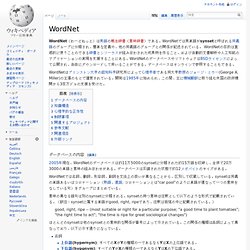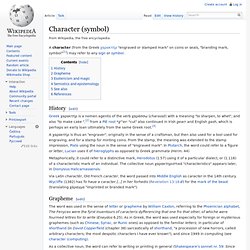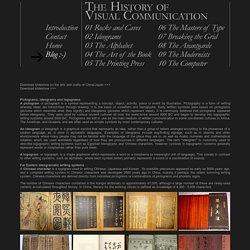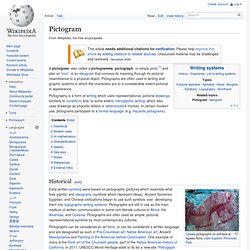

WordNet. WordNet(わーどねっと)は英語の概念辞書(意味辞書)である。

WordNetでは英単語がsynsetと呼ばれる同義語のグループに分類され、簡単な定義や、他の同義語のグループとの関係が記述されている。 WordNetの目的は直感的に使うことのできる辞書とシソーラスが組み合わされた成果物を作ること、および自動的文書解析や人工知能のアプリケーションの実現を支援することにある。 WordNetのデータベースやソフトウェアはBSDライセンスによって公開され、自由にダウンロードして用いることができる。 データベースはオンラインで参照することもできる。 WordNetはプリンストン大学の認知科学研究所によって心理学者である同大学教授のジョージ・ミラー(George A. データベースの内容[編集] 2005年現在、WordNetのデータベースは約11万5000のsynsetに分類された約15万語を収録し、全体で20万3000の単語と意味の組み合わせがある。
WordNetでは名詞、動詞、形容詞、副詞を文法上の扱いが異なることから、区別して収蔵している。 意味の異なる語句は別のsynsetに分類される。 Good, right, ripe -- (most suitable or right for a particular purpose; "a good time to plant tomatoes"; "the right time to act"; "the time is ripe for great sociological changes") ほとんどのsynsetは他のsynsetとの意味的な関係が番号によって示されている。 名詞 上位語(hypernym): すべてのXがYの種類の一であるならYはXの上位語である。
Synsetに含まれる語句は同じ意味を持った同義語であるため意味的な関係はsynset内全体に適用されるが、 単独の語句が他の語句と反意語や派生語などの関係を結ぶこともある。 WordNetには語句の多義性の度合い(polysemy count; 語句が属するsynsetの数)の情報も含まれている。 単語から語幹(英:root form)や原型(英:lemma)を推定するための形態素解析ツールはデータベースと一緒に配布されている。 知識構造[編集] Stimdatabases - Methods. This page provides links to databases or other web-sites which may be useful for the selection, evaluation or manipulation of stimulus material.

There is information on General PsychWiki Archive (useful links to norms, stimuli, data etc.) Overview of Published Norms (From "Behavior Research Methods, Instruments, & Computers" - up to 1999) Searchable Archive of the Psychonomic Society (description) "Mix and Match" Software (for stimulus matching and pseudorandomising) MGH OptSeq (Randomization tool for event-related fMRI designs) fmripower (matlab based power calculation tool for group fMRI studies) The R Project for Statistical Computing R Seek (Search engine for R-related issues) Open Science Framework (on-line depository for pre-registered studies)
WordNet Search - 3.1. 日本語 Wordnet. Archives of data and stimuli. Kanji frequency list of Nozaki. Chinese logographic writing system - OzIdeas. What is the History of Pictographs? Print Email Save Main Image: A pictograph also known as pictogram is a symbol of the pictorial graphic system.

It is a prehistoric drawing on ancient rocks and is essentially a picture of the objects they signify while an ideogram is a symbol that represents a concept or idea. What is the History of Pictographs? Pictographs formed the basis for early written symbols as used by ancient Egyptian, Sumerian and Chinese civilizations. What is the Advantage of Pictographs? Pictographs use graphic symbols and can thus communicate easily and effectively to speakers of different cultures and languages. What is the Modern Use of Pictographs? Pictographs are commonly used today as pictorial signs, statistical diagrams or instructions in various fields. How is Pictograph used in Poetry and Art? Pictographs were widely used in Ancient Egypt and Chinese literature. Related Videos: Grapheme. The word grapheme is derived from Greek γράφω gráphō ("write"), and the suffix -eme, by analogy with phoneme and other names of emic units.
The study of graphemes is called graphemics. Notation[edit] Graphemes are often notated within angle brackets, as 〈a〉, 〈B〉, etc.[1] This is analogous to the slash notation (/a/, /b/) used for phonemes, and the square bracket notation used for phonetic transcriptions ([a], [b]). Glyphs and allographs[edit] Character (symbol) Greek χαρακτήρ is a nomen agentis of the verb χαράσσω (charassō) with a meaning "to sharpen, to whet", and also "to make cake ",[2] from a PIE root *g'ʰer- "cut" also continued in Irish gearr and English gash, which is perhaps an early loan ultimately from the same Greek root.[3] A χαρακτήρ is thus an "engraver", originally in the sense of a craftsman, but then also used for a tool used for engraving, and for a stamp for minting coins.

From the stamp, the meaning was extended to the stamp impression, Plato using the noun in the sense of "engraved mark". In Plutarch, the word could refer to a figure or letter, Lucian uses it of hieroglyphs as opposed to Greek grammata (Herm. 44) The History of Visual Communication - Ideograms. Download slideshow on the arts and crafts of China/Japan >>> Download slideshow >>> Pictograms, ideograms and logograms A pictogram or pictograph is a symbol representing a concept, object, activity, place or event by illustration.

Pictography is a form of writing whereby ideas are transmitted through drawing. It is the basis of cuneiform and hieroglyphs. Pictograms, Ideograms, Icons & Logos. Have you heard the one about the pictogram, the ideogram, the icon and the logo?
They all appeared on a sign together and everybody was lost, insulted and confused! What makes pictograms, ideograms, icons or logos so effective can also be their undoing, resulting in unconvincing messages when applied carelessly. If the image being portrayed is unrecognisable or ambiguous, the viewer will be confused at the least, but if culturally insensitive or misleading could result in offence or unpleasant misinterpretation. Determining what the differences are between the four can be a significant start with a view to avoiding their misuse and deciding how and where to use them, while identifying what images are most effective.
Pictogram. A pictogram, also called a pictogramme, pictograph, or simply picto,[1] and also an 'icon', is an ideogram that conveys its meaning through its pictorial resemblance to a physical object.

Pictographs are often used in writing and graphic systems in which the characters are to a considerable extent pictorial in appearance. Pictography is a form of writing which uses representational, pictorial drawings, similarly to cuneiform and, to some extent, hieroglyphic writing, which also uses drawings as phonetic letters or determinative rhymes. In certain modern use, pictograms participate to a formal language (e.g. Hazards pictograms). Historical[edit]